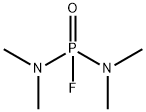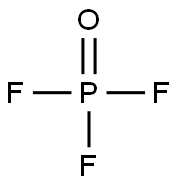DIMEFOX
Synonym(s):Anti-Brain finger protein;BFP;Brain finger protein;
- CAS NO.:115-26-4
- Empirical Formula: C4H12FN2OP
- Molecular Weight: 154.12
- MDL number: MFCD00055417
- EINECS: 204-076-8
- SAFETY DATA SHEET (SDS)
- Update Date: 2024-12-18 14:08:57

What is DIMEFOX?
Description
Dimefox is a clear liquid. Molecularweight=154.14; Boiling point=86℃ at 15 mmHg. Hazard Identification (based on NFPA-704 M Rating System):Health 4, Flammability 1, Reactivity 1. Soluble in water.
Chemical properties
Colorless liquid; fishy odor; bp 86 °C(186.8 °F) at 15 torr; vapor pressure 0.36 at25 °C (77 °F) (Martin 1974); specific gravity 1.115 at 20 °C (68 °F); oxidized slowly instrong oxidizing agents; decomposes in presence of chlorine; readily soluble in water andin most organic solvents.
The Uses of DIMEFOX
Insecticide; acaricide.
Definition
ChEBI: Dimefox is a phosphoramide.
General Description
Colorless liquid with a fishy odor. Used as an insecticide; is neither produced nor used in the U.S. Not registered as a pesticide in the U.S.
Reactivity Profile
Highly toxic fumes are given off upon decomposition of DIMEFOX with heat. Container may explode in heat of fire. Decomposes rapidly in the presence of chlorine. Oxidizes slowly in strong oxidizing agents. [EPA, 1998]. Organophosphates are susceptible to formation of highly toxic and flammable phosphine gas in the presence of strong reducing agents such as hydrides. Partial oxidation by oxidizing agents may result in the release of toxic phosphorus oxides.
Health Hazard
DIMEFOX is extremely toxic; the probable oral lethal dose (human) is 5-50 mg/kg, or 7 drops to 1 teaspoonful for a 150-lb. person. Death may occur from respiratory arrest. Hazards of vapor toxicity are high.
Health Hazard
Although structural feature in the moleculevaries from most other organophosphoruspesticides, the toxic actions are similarto parathion and other phosphate esters.Extremely toxic by all routes of exposure;cholinesterase inhibitor; can present a serious inhalation hazard, if spilled, due to relatively high vapor pressure; exhibits acute,delayed, and chronic effects; symptoms ofcholinergic effects similar to those of otherorganophosphates; death can result from res-piratory arrest; ingestion of 0.3–2 g could befatal to adult human.
LD50 oral (rat): 1.0 mg/kg.
Fire Hazard
(Non-Specific -- Insecticide, Liquid, Poisonous, n.o.s.) Highly toxic fumes are given off upon decomposition with heat. Container may explode in heat of fire. Decomposes rapidly in the presence of chlorine. Oxidizes slowly in strong oxidizing agents.
Safety Profile
Poison by ingestion, skin contact,intraperitoneal, subcutaneous, and intravenous routes.When heated to decomposition it emits very toxic fumesof F-, NOx, and POx.
Potential Exposure
Those involved in the manufacture,formulation, and application of this pesticide.
First aid
If this chemical gets into the eyes, remove anycontact lenses at once and irrigate immediately for at least 15 min, occasionally lifting upper and lower lids. Seek medical attention immediately. If this chemical contacts theskin, remove contaminated clothing and wash immediatelywith soap and water. Speed in removing material from skinis of extreme importance. Shampoo hair promptly if contaminated. Seek medical attention immediately. If thischemical has been inhaled, remove from exposure, beginrescue breathing (using universal precautions, includingresuscitation mask) if breathing has stopped and CPR ifheart action has stopped. Transfer promptly to a medicalfacility. When this chemical has been swallowed, get medical attention. Give large quantities of water and inducevomiting. Do not make an unconscious person vomit. Keepvictim quiet and maintain normal body temperature. Effectsmay be delayed; keep victim under observation.
storage
Color Code—Blue: Health Hazard/Poison: Storein a secure poison location. Prior to working with dimefoxyou should be trained on its proper handling and storage.Store in tightly closed containers in a cool, well-ventilatedarea away from strong oxidizers, strong acids, halogens.Metal containers involving the transfer of this chemicalshould be grounded and bonded. Where possible, automatically pump liquid from drums or other storage containers toprocess containers. Drums must be equipped with self-closing valves, pressure vacuum bungs, and flame arresters. Useonly nonsparking tools and equipment, especially whenopening and closing containers of this chemical. Sources ofignition, such as smoking and open flames, are prohibitedwhere this chemical is used, handled, or stored in a mannerthat could create a potential fire or explosion hazard.Wherever this chemical is used, handled, manufactured, orstored, use explosion-proof electrical equipment andfittings.
Shipping
Organophosphorus pesticides, liquid, toxic, n.o.s.require a “POISONOUS/TOXIC MATERIALS” label.Dimefox falls in Hazard Class 6.1 and because it isextremely toxic, in Packing Group I.
Incompatibilities
Strong oxidizers may cause release oftoxic phosphorus oxides. Organophosphates, in the presenceof strong reducing agents such as hydrides, may formhighly toxic and flammable phosphine gas. Keep awayfrom alkaline materials, strong acids, halogens.
Properties of DIMEFOX
| Boiling point: | 126℃ (60 Torr) |
| Density | 1.1151 g/cm3 (20 ºC) |
| refractive index | 1.4267 (589.3 nm 20℃) |
| Flash point: | 100 °C |
| storage temp. | +4°C
|
| solubility | Chloroform (Slightly), Ethyl Acetate (Slightly), Methanol (Slightly) |
| pka | -0.24±0.70(Predicted) |
| form | Liquid |
| Merck | 13,3229 |
| Stability: | Moisture Sensitive |
| EPA Substance Registry System | Dimefox (115-26-4) |
Safety information for DIMEFOX
| Signal word | Danger |
| Pictogram(s) |
 Skull and Crossbones Acute Toxicity GHS06 |
| GHS Hazard Statements |
H300:Acute toxicity,oral H310:Acute toxicity,dermal |
| Precautionary Statement Codes |
P264:Wash hands thoroughly after handling. P264:Wash skin thouroughly after handling. P280:Wear protective gloves/protective clothing/eye protection/face protection. P310:Immediately call a POISON CENTER or doctor/physician. P302+P350:IF ON SKIN: Gently wash with plenty of soap and water. |
Computed Descriptors for DIMEFOX
New Products
Tert-butyl bis(2-chloroethyl)carbamate (S)-3-Aminobutanenitrile hydrochloride N-Boc-D-alaninol N-BOC-D/L-ALANINOL N-octanoyl benzotriazole 3,4-Dibenzyloxybenzaldehyde 4-Hydrazinobenzoic acid 1,1’-CARBONYLDIIMIDAZOLE R-2-BENZYLOXY PROPIONIC ACID 4-HYDROXY BENZYL ALCOHOL 1,1’-CARBONYLDI (1,2-4 TRIAZOLE) 4-IODO BENZOIC ACID (2-Hydroxyphenyl)acetonitrile 4-Bromopyrazole 5-BROMO-2CYANO PYRIDINE 5,6-Dimethoxyindanone 5-broMo-2-chloro-N-cyclopentylpyriMidin-4-aMine 2-(Cyanocyclohexyl)acetic acid 4-methoxy-3,5-dinitropyridine 2-aminopropyl benzoate hydrochloride 1-(4-(aminomethyl)benzyl)urea hydrochloride tert-butyl 4- (ureidomethyl)benzylcarbamate diethyl 2-(2-((tertbutoxycarbonyl)amino) ethyl)malonate Ethyl-2-chloro((4-methoxyphenyl)hydrazono)acetateRelated products of tetrahydrofuran
You may like
-
 873-83-6 6-Aminouracil (or) 4-Amino-2,6- dihydroxypyrimidine, (or) 6-Amino2,4-pyrimidinediol 99%View Details
873-83-6 6-Aminouracil (or) 4-Amino-2,6- dihydroxypyrimidine, (or) 6-Amino2,4-pyrimidinediol 99%View Details
873-83-6 -
 55441-95-7 99%View Details
55441-95-7 99%View Details
55441-95-7 -
 N-Vinylformamide 99%View Details
N-Vinylformamide 99%View Details
13162-05-5 -
 Chloro Uracil 1820-81-1 99%View Details
Chloro Uracil 1820-81-1 99%View Details
1820-81-1 -
 207557-35-5 99%View Details
207557-35-5 99%View Details
207557-35-5 -
 2-ethyl-6-methyl-3-hydroxypyridine succinate 99%View Details
2-ethyl-6-methyl-3-hydroxypyridine succinate 99%View Details
127464-43-1 -
 2-ETHYLPYRIDINE 100-71-0 99%View Details
2-ETHYLPYRIDINE 100-71-0 99%View Details
100-71-0 -
 181228-33-1 (S)-Methyl 3-amino-2-((tert-butoxycarbonyl)amino)propanote Hydrochloride (DAP-OMe. HCl) 99%View Details
181228-33-1 (S)-Methyl 3-amino-2-((tert-butoxycarbonyl)amino)propanote Hydrochloride (DAP-OMe. HCl) 99%View Details
181228-33-1



